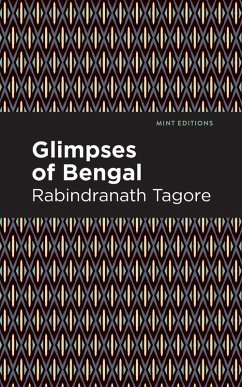
Glimpses of Bengal
The Letters of Rabindranath Tagore
Versandkostenfrei!
Versandfertig in über 4 Wochen
9,99 €
inkl. MwSt.

PAYBACK Punkte
5 °P sammeln!
Glimpses of Bengal: The Letters of Tagore (1917) is a selection of letters by Rabindranath Tagore. Published after Tagore received the 1913 Nobel Prize in Literature, Glimpses of Bengal: The Letters of Tagore collects letters from 1885 to 1895, a period designated by the author as "the most productive period of [his] literary life." Bridging the gap between fiction and nonfiction, these letters contain personal reflections on the political situation in India, mediations on nature and poetry, and stunning vignettes of life in the nineteenth century. "The unsheltered sea heaves and heaves and bl...
Glimpses of Bengal: The Letters of Tagore (1917) is a selection of letters by Rabindranath Tagore. Published after Tagore received the 1913 Nobel Prize in Literature, Glimpses of Bengal: The Letters of Tagore collects letters from 1885 to 1895, a period designated by the author as "the most productive period of [his] literary life." Bridging the gap between fiction and nonfiction, these letters contain personal reflections on the political situation in India, mediations on nature and poetry, and stunning vignettes of life in the nineteenth century. "The unsheltered sea heaves and heaves and blanches into foam. It sets me thinking of some tied-up monster straining at its bonds, in front of whose gaping jaws we build our homes on the shore and watch it lashing its tail." In this selection of letters, Tagore is at his philosophical, poetic best, reflecting earnestly and with ease on matters public and private. A young man, he writes with the clarity and wisdom of one who has lived many times over, granting readers a glimpse of the iconic figure he would become toward the end of his life and career. His portrait of Bengal is heartfelt and true, unadorned and yet possessing an almost mystical quality. Whether describing his travels upriver by boat or a dream journey through a Calcutta immersed in "a dense, dark mist," Tagore never fails to intrigue, enrapture, and enlighten. This edition of Rabindranath Tagore's Glimpses of Bengal: The Letters of Tagore is a classic of Indian literature reimagined for modern readers. Since our inception in 2020, Mint Editions has kept sustainability and innovation at the forefront of our mission. Each and every Mint Edition title gets a fresh, professionally typeset manuscript and a dazzling new cover, all while maintaining the integrity of the original book. With thousands of titles in our collection, we aim to spotlight diverse public domain works to help them find modern audiences. Mint Editions celebrates a breadth of literary works, curated from both canonical and overlooked classics from writers around the globe.













